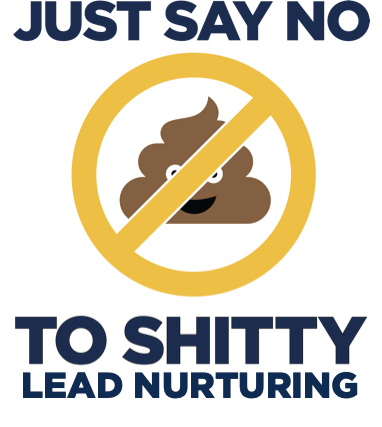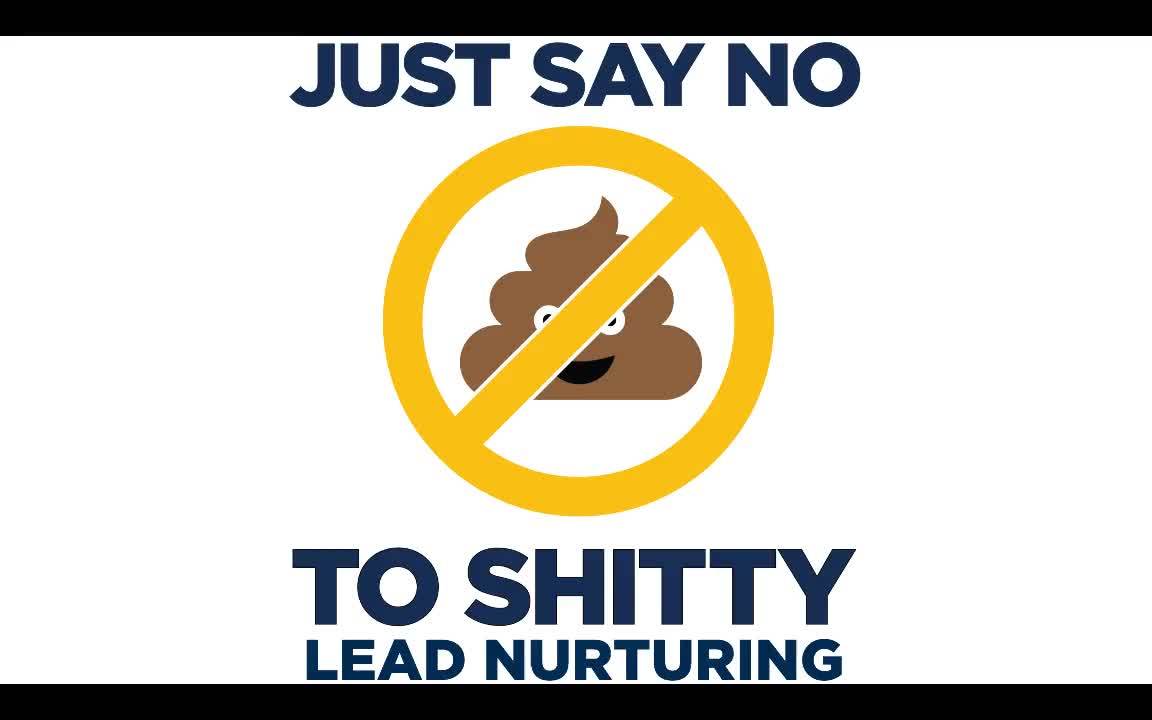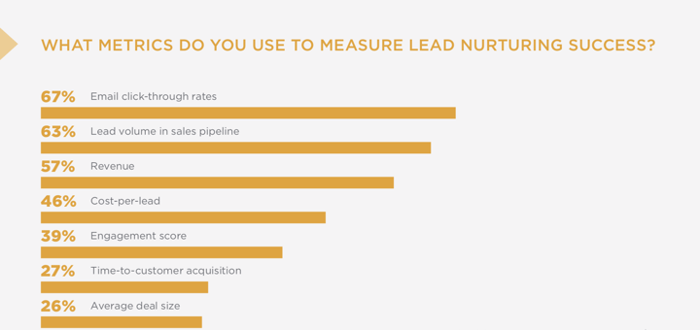 Welcome to this edition of Just Say No to Shitty Sales & Marketing; today I’m focused on lead nurturing. No tactic that is more consistently used and important through the entire customer acquisition and success process than email.
Welcome to this edition of Just Say No to Shitty Sales & Marketing; today I’m focused on lead nurturing. No tactic that is more consistently used and important through the entire customer acquisition and success process than email.
Email is a critical component and in many ways, it's the only channel that we truly, fully own to create a one-to-one communication mechanism. Your ability to master email in general and lead nurturing specifically has a tremendous impact on your ability to grow consistently and to grow smart. But why does so much lead nurturing suck? You know what I'm talking about. You get the same “nurturing” emails that I get and well, the nurturing is anything but, well, nurturing.
What is the purpose of lead nurturing? Why is lead nurturing so important? The numbers are going to speak for themselves. Companies that do lead nurturing well enjoy significant enhancements in the results that they get. But, you need to understand that just because you do lead nurturing, or maybe what I should say is just because you call something lead nurturing, doesn't mean that it's gonna drive these types of results:
- Leads who are effectively nurtured generate 20% more sales opportunities than those that aren't effective.
- Lead nurturing generates 50% more sales-ready leads.
- Nurtured leads make 47% larger purchases.
- Relevant emails drive 18 times more revenue acquisition than just broadcast emails.
- 82% of prospects say lead nurturing that was targeted and specific to them influenced their ability to make decisions.
Effective lead nurturing drives better results. There’s no question about it. When you consider that 75% or more of the leads that we generate are not ready to buy it quickly becomes clear why lead nurturing is so important.
BUT. IT’S. NOT. WORKING. It's like we’ve taken “boiler room” come out of the boiler room. Our entire approach to customer acquisition has become so flash in the pan. It’s like if you're not ready to buy then sellers don't have time for you in their approaches.
I know how hard it is to generate the engagement of a lead/prospect that fits your ideal client profile. I know how hard it is from the perspective of the seller or the marketer. I also know how it feels from the perspective of the buyer and I'll speak for myself.

When I interact with companies that are doing things that I'm intrigued by and I want to know how they do what they do and how can they impact or benefit me, It's like they've all read the same playbook. They’ve heard that “customers are doing their own self-journey,” so if a prospect is not ready to buy, then the prospect is on their own to figure it out. If that works for you, then hey, who am I to tell you not to do that, but what’s the cost?
Company databases have multiplied over the last few years. You’re likely generating more leads than you ever have, but most of them are not ready to buy and - BELIEVE IT OR NOT - most people don’t want to figure it out on their own. Your database likely represents an extraordinarily valuable, but latent, asset that you've spent a considerable amount of money to build.
And you’re blowing it! It's not just me saying that. A report from DemandGen & Vidyard shows that 86% of marketers rate their current lead nurturing initiatives as average or below average.
86% average or below...Are you kidding me?
The Objective of a Strong Lead Nurturing Strategy

What's the purpose of lead nurturing? Well, the answer is in the question. It is to nurture, to cultivate, to care for. What, what image comes to mind when I say lead, nurture? Well, it's probably something like the image here, delicately watering grass so that it'll grow, but we that’s now how we’re executing lead nurturing strategies.
The problem, however, is not the strategy, it's the objective and the metrics that are being used to manage it. We’ve taken metrics that were byproducts of effective nurturing and turned them into the objective.
In the same research that 86% of people said that their lead nurturing was average. They were also asked, what metrics do you use to measure success:

Coming in as the #1 metric, 67% of respondents use click-through rates as a primary measure. 67%! Seriously? We're still worshiping at the altar of click-through rates.
Email marketers are so obsessed with click rates, that Websters had to add a new word to their dictionary - click-bait. It’s gotten so bad that I’m often wary to click on links (in emails or websites). I look at something and I'm intrigued by it. I'm about to click on it and I think, “What's the catch? They're just going to sell me. It's not even gonna show I want to see anyway.”
Somewhere in the pantheon of email marketing, we forgot that emails should be designed to be read. I hear it all the time - emails have to be short, short. If an email isn’t short, it won’t work.
But I’ve got some news for you. I've seen and measured the time that someone spends on an email and I can tell you that if the email is relevant and well-written people will spend time engaged with the email, and the length of the email is, at most, a secondary factor.
It’s not until we get to the 5th metric, at 39%, that the word “engagement” enters the picture - and engagement should be the primary objective of any non-transactional/non-ecommerce email marketing strategy.
So, now that you know what you should do, what are some things to avoid?
The 5 Problems That Kill Your Lead Nurturing Efforts
1. Blast Mentality
Companies are sending more emails than ever. There seems to be a belief that because sending email is free, there's no cost. The reality is there is no space more competitive than your desired recipient's inbox. Respect the inbox. You'll see greater results and be far better off if you send fewer, better emails rather than increasing (or even maintaining) your current volume.
2. The “Full Funnel” Nurture Approach
This is the most common email nurture that I see. This nurture is supposed to take you from the beginning to the end. The first email in the nurture is top-of-funnel. It's interesting and intriguing. The second email begins to move the lead further down the funnel and by the fourth, fifth or sixth email, it’s saying something like, “Hey, here's what you can buy us, here's why we should talk.”
We either think that the people making decisions are traversing their entire journey in the exact time span of our lead nurture or we believe that our lead nurture is actually going to lead them through it. Look, if I download your paper on why widget manufacturing costs are 5% higher than they should be but I’m not looking to do anything, I’m still likely not going to be thinking about doing anything by your fourth or fifth email either.
Nurturing is far more effective when it’s journey specific.
3. Nurturing to Sell
I'm seeing this at a rate that I haven't seen in more than 20 years. Marketers are using content that should be focused on educating and increasing engagement to try to sell (often in place of a salesperson). Marketers are obsessed with finding that magic phrase that will click in the lead’s head and drive them to buy.
Nurtures should educate, inform, deliver insights, and enhance engagement. There's only one metric that matters for a lead nurture and that's engagement. If you increase engagement, then you've got the raw material for conversion, for conversation, and for opportunities.
You’ll build the most powerful assets in the world: permission and attention.
4. Executing Your Lead Nurture “In a Silo”
We send our lead nurtures irrespective of everything else that's going on. So when I read an email, and then I go to your website, often the two have nothing in common. Or, I talk to your salesperson and it feels entirely different.
Lead nurturing is more than email and it’s happening all the time. Alignment is crucial for effective nurturing.
5. Focusing on The Wrong Metrics
Your metrics should be tied to the intent of your nurture. Think “what are we ‘hiring’ this nurture to do for us?” then tie your metrics to that purpose. Your early-stage emails have different roles than your late-stage nurture and they should have different metrics.
When you use the same metrics to judge all your nurtures, you take the one lowest common denominator approach, which leads to “average.” And that’s why 86% of people doing lead nurturing feel like theirs is average or worse.
The Keys to Unlocking Effective Lead Nurturing
1. Teach something valuable
Create value in your emails and, remember, value is in the eye of the beholder. I love what John Bonini says about writing an email: take all of the links out of your email and if you were to read the email with no links, would you have been happy you got it?
2. Make nurturing omnichannel
The way your customers engage with you is highly variant. It depends on who they are, what their situation is, their context, their personalities, and a myriad of other factors. Be sure that however they want to engage, you're in a position to do so.
Your nurturing has to be aligned so it's aligned across the board. You must deliver a consistent, coherent, relevant experience that’s aligned with their journey. Enable your audience to give you their signal. Let their patterns and behavior signal to you where they are in the journey, and then let that signal trigger the appropriate action.
3. Align your metrics
Build the metrics that support and align with the purpose of your nurtures, and you'll start delivering effective lead nurturing. What's more, you'll be able to spend less time, have fewer headaches, and a much more engaged audience. You'll start seeing your sales increase without having to work so hard to do so.
That's it. That's how you deliver effective lead nurturing. If you have any questions about your lead nurture strategy, please don't hesitate to reach out. Thanks for joining me.

 Doug Davidoff
Doug Davidoff